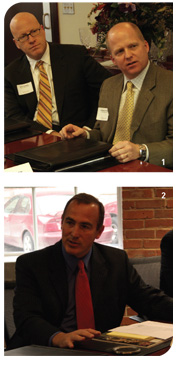The Baby Boom
In 2007, the oldest baby boomers turned 62. In the years ahead there will be a flood of people retiring. The quest-ion was raised as to how that would affect the wealth management business.
Mark Revenaugh explained that a lot of money was going to move out of qualified plans and employer funds. He noted that those folks that have already been getting financial advice will continue to get that advice but with more available money now in play.
Although the consensus seemed to be that this first phase of the baby boom would be good for business, Steve Toomey cautioned that many clients were exiting the growth phase and entering a “de-accumulation phase.”
Bob Mulleedy attested that the advertisers were now playing to the population responsive to the message, “You have accumulated X number of dollars. What are you going to live on?”
Others countered, however, that people are continuing to work longer than they did in the past. “I am a firm believer that you don’t retire from something, you retire to something,” offered Tommy Taylor, adding, “Couch potatoism is a death sentence.”
“I think the clients I really enjoy working with,” said Don Hubbs, “are the business owners that just decide not to retire because they’re having so much fun running their business.”

1: Steve Toomey (right) shares his perspectives on external marketing strategies. Scott Boswell, of Commerce Trust Company, looks on. | 2: Don Hubbs, of The PrivateBank, says serving one’s clients well is the best marketing strategy.
Intergenerational Issues
With people living longer, the group was asked whether intergenerational issues were becoming more difficult to manage, especially given that three and even four-generation relationships with a wealth manager were no longer unusual.
The group answered in the affirmative. “I think you better take care of the person that you’re managing their money for today,” said Don Hubbs. He did acknowledge, however, that this might cause conflict with those that in-tend to inherit that money in question. As example of that latter phenomenon, Bob Mulleedy conceded that he sometimes has to be the bearer of bad news, like “Your dad is never going to retire and you guys are never going to get this much and that’s the way it’s going to be.” Said Mulleedy, “That’s a tough message to bring.”
“Probably the worst stewards of money are the ones who had nothing and then all of a sudden have millions of dollars,” affirmed Ken Eaton. “So we encourage our clients to start transferring wealth while they are still alive, not for estate planning, but first of all be-cause they can teach the kids early on.”
Mark Vlasic also believes in encouraging that first generation to include the second generation in planning sessions with him or his colleagues. In at least one case, a client of his required every one of his children to have a financial plan so that there would be a coordinated wealth preservation strategy long after they were gone.
As Stewart Koesten noted, it is usually the middle generation that creates the wealth, and they share it with both their parents and their children.
Brewster Ellis has observed the same phenomenon, clients who take care of both children and parents.” We talked
a lot about managing assets, pension, portfolios; another big thing that needs to be managed is liabilities.”
Ellis commented that the average age of a Merrill Lynch client is 67 years old. “So what does that tell you?” he asked. “That tells you better be in the generational relationship business.” Ideally, he added, the wealth manager’s relationship with the younger generation will develop over time and mature.
Bob Rippy suggested another wrinkle, the “graying” of the wealth management industry. The average age of an advisor is well into the 50s. On the positive side, added Rippy, “Those who stay will probably do very well.”
Relationships as Friendships
Given the importance of relationships in doing business, the question was raised as to whether clients become friends and, if so, whether that was a good thing.
Brewster Ellis considers his clients friends first. “And yes,” he conceded, “there is a downside to that.” From a firm perspective, he often finds himself on the client side of the table. There is also a stewardship responsibility that he shares with his client and their offspring. “So that’s a large risk, keeping that all in perspective,” he added.
“There is no requirement that a good client become your best buddy,” said Stewart Koesten, “but in a lot of cases, if you do wonderful work for a client, they do become friends of yours.” He did not see a down side to that.
Mark Revenaugh agreed: “When you have a business relationship that turns into a friendship, it’s really one of the more successful business relationships you can have.”
As an NFL quarterback for several seasons, Mark Vlasic started working with a financial advisor at a relatively early age. Although he was reluctant initially to work with a friend, he no longer would be. “That trust component is huge,” he noted, “and that’s naturally built into a friendship.”
(...continued)